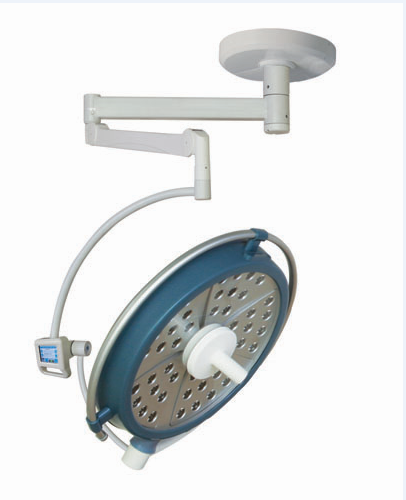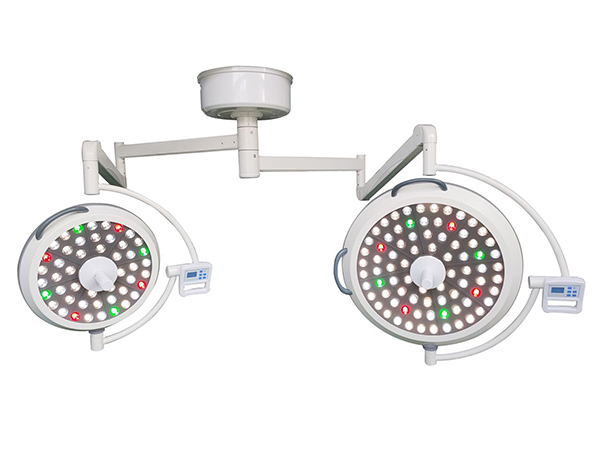LED shadowless lamps are commonly used lighting devices in the medical field, and their performance directly affects the operational accuracy and safety of surgical and other scenarios. The following is an introduction from the core performance dimension:
1、 Optical performance: precise light control and shadowless effect
• Shadowless rate and illumination uniformity: By arranging multiple sets of LED light sources in a circular pattern and utilizing the principles of optical refraction and superposition, the central dark area of object projection is eliminated, and the shadowless rate can reach over 99%. For example, the central illumination of the surgical lamp is usually adjustable between 30000 and 160000 lux, and the uniformity of illumination within the spot is ≥ 85%, ensuring consistent lighting in every corner of the surgical field and avoiding operational errors caused by shadows.
• Color temperature and color rendering: The color temperature is mostly 4000K-6000K (close to natural light), and the color rendering index (CRI) is ≥ 95, which can truly restore the color details of tissues and organs. 6000K cool white light can reduce blood reflection, help doctors distinguish subtle color differences between different tissues, and improve surgical accuracy.
2、 Energy saving and lifespan: the core advantage of low consumption and long-term effectiveness
Energy consumption performance: Compared to traditional halogen lamps, LED light sources reduce power consumption by 50% -70%. Taking the 400W tungsten halogen lamp as an example, the power of an LED shadowless lamp with the same illuminance is only 150-200W. With the intelligent dimming system, the brightness can be dynamically adjusted according to surgical needs, further saving energy consumption.
• Service life: The service life of LED chips is usually ≥ 50000 hours (can work continuously for 17 years if used for 8 hours a day), and the light decay is slow (the luminous flux decay is ≤ 10% after 30000 hours of use), reducing the maintenance cost of frequent replacement of light sources.
3、 Heat dissipation and temperature control: key to ensuring stability
• Heat dissipation design: Adopting aluminum alloy fin heat dissipation structure or air cooling system to quickly dissipate the heat generated by the LED. For example, the heat dissipation efficiency of high-end shadowless lamps can reach below 0.5 ℃ per watt, ensuring that the lamp head temperature is ≤ 40 ℃ to avoid affecting the light source performance or burning the surgical field tissue due to high temperatures.
Temperature rise control: The temperature difference between the surface of the lamp head and the environment is ≤ 15 ℃, and the infrared radiation is low (IR radiation ≤ 500W/㎡), reducing thermal damage to the surgical area, especially suitable for long-term precision surgery.
4、 Intelligence and control experience
Intelligent dimming and memory function: supports touch or foot switch adjustment of brightness and color temperature, and some models can store lighting parameters for different surgical scenarios (such as high brightness required for orthopedic surgery and soft light source required for ophthalmic surgery), with one click switching to improve efficiency.
• Dynamic tracking and positioning: Through the design of a balance arm or robot joint, the lamp head can rotate 360 ° and pitch 180 °, combined with a gravity sensing system, to achieve precise positioning of “touch and move, release and stop”, avoiding the impact of lamp head shaking on the doctor’s field of view during operation.
5、 Safety and reliability
Emergency power supply and fault-tolerant design: Built in backup battery, can maintain lighting for ≥ 30 minutes after power failure; Some products use dual LED modules, and in the event of a single group failure, the other group can still function normally, ensuring surgical safety.
Medical grade protection: The lamp head shell is made of antibacterial materials (such as ABS+PC alloy), which can withstand disinfectants such as iodine and alcohol for wiping; The protection level reaches IPX4, preventing liquid splashing from entering the internal circuit.
6、 Application scenario adaptability
According to the needs of different departments, LED shadowless lights can be divided into surgical shadowless lights, examination shadowless lights, and other types. For example, operating room lights require large light spots (diameter 30-50cm) and high illumination, while dental clinic lights focus on small light spots and flexible adjustment. In addition, some products support linkage with the operating room purification system to reduce dust adhesion and maintain a sterile environment.
In summary, LED shadowless lamps have become the mainstream choice for modern medical lighting due to their optical precision, energy-saving and long-lasting performance, and intelligent control. Their technological iteration is also continuously developing towards higher brightness uniformity and lower energy consumption.
Post time: Jun-18-2025



